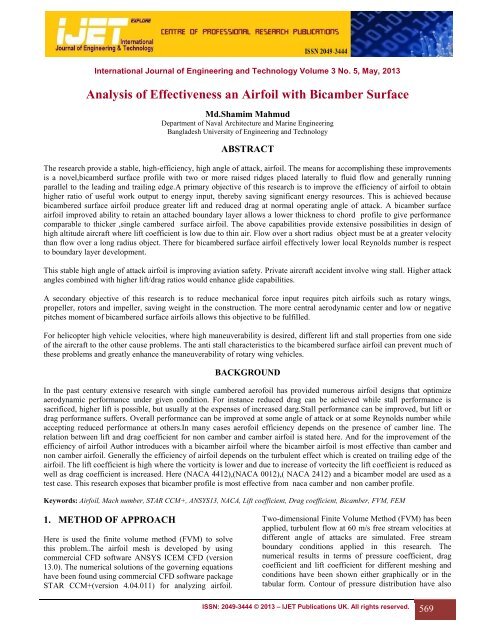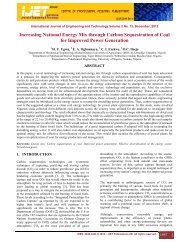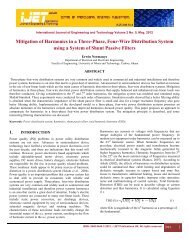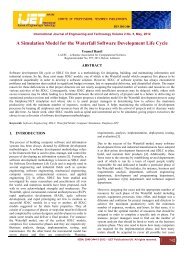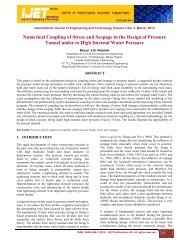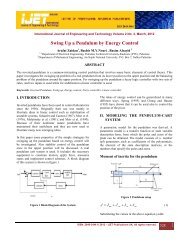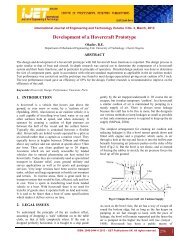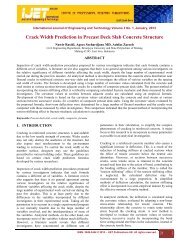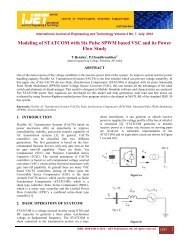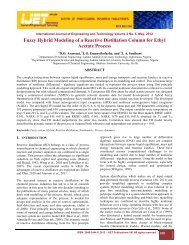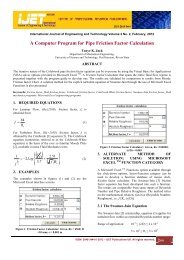Analysis of Effectiveness an Airfoil with Bicamber Surface
Analysis of Effectiveness an Airfoil with Bicamber Surface
Analysis of Effectiveness an Airfoil with Bicamber Surface
You also want an ePaper? Increase the reach of your titles
YUMPU automatically turns print PDFs into web optimized ePapers that Google loves.
International Journal <strong>of</strong> Engineering <strong>an</strong>d Technology Volume 3 No. 5, May, 2013<br />
<strong>Analysis</strong> <strong>of</strong> <strong>Effectiveness</strong> <strong>an</strong> <strong>Airfoil</strong> <strong>with</strong> <strong>Bicamber</strong> <strong>Surface</strong><br />
Md.Shamim Mahmud<br />
Department <strong>of</strong> Naval Architecture <strong>an</strong>d Marine Engineering<br />
B<strong>an</strong>gladesh University <strong>of</strong> Engineering <strong>an</strong>d Technology<br />
ABSTRACT<br />
The research provide a stable, high-efficiency, high <strong>an</strong>gle <strong>of</strong> attack, airfoil. The me<strong>an</strong>s for accomplishing these improvements<br />
is a novel,bicamberd surface pr<strong>of</strong>ile <strong>with</strong> two or more raised ridges placed laterally to fluid flow <strong>an</strong>d generally running<br />
parallel to the leading <strong>an</strong>d trailing edge.A primary objective <strong>of</strong> this research is to improve the efficiency <strong>of</strong> airfoil to obtain<br />
higher ratio <strong>of</strong> useful work output to energy input, thereby saving signific<strong>an</strong>t energy resources. This is achieved because<br />
bicambered surface airfoil produce greater lift <strong>an</strong>d reduced drag at normal operating <strong>an</strong>gle <strong>of</strong> attack. A bicamber surface<br />
airfoil improved ability to retain <strong>an</strong> attached boundary layer allows a lower thickness to chord pr<strong>of</strong>ile to give perform<strong>an</strong>ce<br />
comparable to thicker ,single cambered surface airfoil. The above capabilities provide extensive possibilities in design <strong>of</strong><br />
high altitude aircraft where lift coefficient is low due to thin air. Flow over a short radius object must be at a greater velocity<br />
th<strong>an</strong> flow over a long radius object. There for bicambered surface airfoil effectively lower local Reynolds number is respect<br />
to boundary layer development.<br />
This stable high <strong>an</strong>gle <strong>of</strong> attack airfoil is improving aviation safety. Private aircraft accident involve wing stall. Higher attack<br />
<strong>an</strong>gles combined <strong>with</strong> higher lift/drag ratios would enh<strong>an</strong>ce glide capabilities.<br />
A secondary objective <strong>of</strong> this research is to reduce mech<strong>an</strong>ical force input requires pitch airfoils such as rotary wings,<br />
propeller, rotors <strong>an</strong>d impeller, saving weight in the construction. The more central aerodynamic center <strong>an</strong>d low or negative<br />
pitches moment <strong>of</strong> bicambered surface airfoils allows this objective to be fulfilled.<br />
For helicopter high vehicle velocities, where high m<strong>an</strong>euverability is desired, different lift <strong>an</strong>d stall properties from one side<br />
<strong>of</strong> the aircraft to the other cause problems. The <strong>an</strong>ti stall characteristics to the bicambered surface airfoil c<strong>an</strong> prevent much <strong>of</strong><br />
these problems <strong>an</strong>d greatly enh<strong>an</strong>ce the m<strong>an</strong>euverability <strong>of</strong> rotary wing vehicles.<br />
BACKGROUND<br />
In the past century extensive research <strong>with</strong> single cambered aer<strong>of</strong>oil has provided numerous airfoil designs that optimize<br />
aerodynamic perform<strong>an</strong>ce under given condition. For inst<strong>an</strong>ce reduced drag c<strong>an</strong> be achieved while stall perform<strong>an</strong>ce is<br />
sacrificed, higher lift is possible, but usually at the expenses <strong>of</strong> increased darg.Stall perform<strong>an</strong>ce c<strong>an</strong> be improved, but lift or<br />
drag perform<strong>an</strong>ce suffers. Overall perform<strong>an</strong>ce c<strong>an</strong> be improved at some <strong>an</strong>gle <strong>of</strong> attack or at some Reynolds number while<br />
accepting reduced perform<strong>an</strong>ce at others.In m<strong>an</strong>y cases aer<strong>of</strong>oil efficiency depends on the presence <strong>of</strong> camber line. The<br />
relation between lift <strong>an</strong>d drag coefficient for non camber <strong>an</strong>d camber airfoil is stated here. And for the improvement <strong>of</strong> the<br />
efficiency <strong>of</strong> airfoil Author introduces <strong>with</strong> a bicamber airfoil where the bicamber airfoil is most effective th<strong>an</strong> camber <strong>an</strong>d<br />
non camber airfoil. Generally the efficiency <strong>of</strong> airfoil depends on the turbulent effect which is created on trailing edge <strong>of</strong> the<br />
airfoil. The lift coefficient is high where the vorticity is lower <strong>an</strong>d due to increase <strong>of</strong> vortecity the lift coefficient is reduced as<br />
well as drag coefficient is increased. Here (NACA 4412),(NACA 0012),( NACA 2412) <strong>an</strong>d a bicamber model are used as a<br />
test case. This research exposes that bicamber pr<strong>of</strong>ile is most effective from naca camber <strong>an</strong>d non camber pr<strong>of</strong>ile.<br />
Keywords: <strong>Airfoil</strong>, Mach number, STAR CCM+, ANSYS13, NACA, Lift coefficient, Drag coefficient, <strong>Bicamber</strong>, FVM, FEM<br />
1. METHOD OF APPROACH<br />
Here is used the finite volume method (FVM) to solve<br />
this problem..The airfoil mesh is developed by using<br />
commercial CFD s<strong>of</strong>tware ANSYS ICEM CFD (version<br />
13.0). The numerical solutions <strong>of</strong> the governing equations<br />
have been found using commercial CFD s<strong>of</strong>tware package<br />
STAR CCM+(version 4.04.011) for <strong>an</strong>alyzing airfoil.<br />
Two-dimensional Finite Volume Method (FVM) has been<br />
applied, turbulent flow at 60 m/s free stream velocities at<br />
different <strong>an</strong>gle <strong>of</strong> attacks are simulated. Free stream<br />
boundary conditions applied in this research. The<br />
numerical results in terms <strong>of</strong> pressure coefficient, drag<br />
coefficient <strong>an</strong>d lift coefficient for different meshing <strong>an</strong>d<br />
conditions have been shown either graphically or in the<br />
tabular form. Contour <strong>of</strong> pressure distribution have also<br />
ISSN: 2049-3444 © 2013 – IJET Publications UK. All rights reserved.<br />
569
International Journal <strong>of</strong> Engineering <strong>an</strong>d Technology (IJET) – Volume 3 No. 5, May, 2013<br />
been displayed graphically. And finally calculate the<br />
structural effect <strong>of</strong> camber <strong>an</strong>d bicamber airfoil by using<br />
FEM <strong>an</strong>alysis.<br />
∫<br />
∑ ∑<br />
F D =<br />
L =<br />
C p =<br />
v 2 C d A<br />
v 2 C L A<br />
N face = number <strong>of</strong> faces enclosing cell<br />
= value <strong>of</strong> convected through face f<br />
= mass flux through the face<br />
The tr<strong>an</strong>sport <strong>of</strong> a scalar qu<strong>an</strong>tity<br />
represented by the integral equation:<br />
in a continuum is<br />
= area <strong>of</strong> face f<br />
=gradient <strong>of</strong><br />
at face f<br />
∫ ∮ ⃗ ⃗ ∮ ⃗ ∫<br />
⃗= velocity vector<br />
⃗= surface area vector<br />
= diffusion coefficient for<br />
= gradient <strong>of</strong><br />
= source <strong>of</strong> per unit volume<br />
The terms in this equation are, from left to right, the<br />
tr<strong>an</strong>sient term, the convective flux, the diffusive flux <strong>an</strong>d<br />
the volumetric source term.<br />
Discrete Form:-<br />
Applying the above equation to a cell-centered control<br />
volume for cell-0, the following is obtained:<br />
V = cell volume<br />
<strong>Bicamber</strong>’s maximum thickness is 0.12m <strong>an</strong>d maximum<br />
thickness position is 0.16m from leading edge<br />
Author has taken free stream boundary condition.<br />
Temperature 291k<br />
Dynamic viscosity 4.61×10^-5<br />
Turbulent model, Spalart-Allmaras Turbulence<br />
Velocity 60 m/s<br />
Density <strong>of</strong> air 1.2126 kg/m^3<br />
Mach Number 0.1807<br />
2. RESULT<br />
Fig: Mesh <strong>of</strong> NACA 2412 pr<strong>of</strong>ile<br />
ISSN: 2049-3444 © 2013 – IJET Publications UK. All rights reserved.<br />
570
International Journal <strong>of</strong> Engineering <strong>an</strong>d Technology (IJET) – Volume 3 No. 5, May, 2013<br />
Fig: Mesh <strong>of</strong> <strong>Bicamber</strong> pr<strong>of</strong>ile<br />
Fig: Trailing edge vortecity <strong>of</strong> NACA 2412 pr<strong>of</strong>ile<br />
ISSN: 2049-3444 © 2013 – IJET Publications UK. All rights reserved.<br />
571
International Journal <strong>of</strong> Engineering <strong>an</strong>d Technology (IJET) – Volume 3 No. 5, May, 2013<br />
Fig: clips edge vortecity <strong>of</strong> <strong>Bicamber</strong> pr<strong>of</strong>ile<br />
Fig: Velocity distribution <strong>of</strong> <strong>Bicamber</strong> pr<strong>of</strong>ile<br />
Fig: Mach Number distribution <strong>of</strong> NACA 2412 pr<strong>of</strong>ile<br />
ISSN: 2049-3444 © 2013 – IJET Publications UK. All rights reserved.<br />
572
International Journal <strong>of</strong> Engineering <strong>an</strong>d Technology (IJET) – Volume 3 No. 5, May, 2013<br />
Fig: Mach Number distribution <strong>of</strong> <strong>Bicamber</strong> pr<strong>of</strong>ile<br />
Fig: Drag Coefficient Vs Angle <strong>of</strong> Attack<br />
ISSN: 2049-3444 © 2013 – IJET Publications UK. All rights reserved.<br />
573
International Journal <strong>of</strong> Engineering <strong>an</strong>d Technology (IJET) – Volume 3 No. 5, May, 2013<br />
Validation <strong>of</strong> the result by wind tunnel test data<br />
Fig: Lift coefficient Vs Angle <strong>of</strong> Attack<br />
The two graphs, red line shows the wind tunnel test result <strong>an</strong>d blue line shows FVM simulation result for bicamber pr<strong>of</strong>ile.<br />
ISSN: 2049-3444 © 2013 – IJET Publications UK. All rights reserved.<br />
574
International Journal <strong>of</strong> Engineering <strong>an</strong>d Technology (IJET) – Volume 3 No. 5, May, 2013<br />
3. Model <strong>Analysis</strong>:<br />
Now for structural effect <strong>an</strong>alysis the author is considered 3d NACA <strong>an</strong>d <strong>Bicamber</strong> pr<strong>of</strong>ile.<br />
Cord Length <strong>of</strong> the NACA <strong>an</strong>d <strong>Bicamber</strong> Pr<strong>of</strong>ile 1m <strong>an</strong>d Wideth also 1 m.<br />
Material Name:<br />
Aluminum Alloy 6063T4<br />
Model type:<br />
Linear Elastic Isotropic<br />
Default failure criterion:<br />
Max von Mises Stress<br />
Yield strength:<br />
9e+007 N/m^2<br />
Tensile strength:<br />
1.7e+008 N/m^2<br />
Elastic modulus:<br />
6.9e+010 N/m^2<br />
Poisson's ratio: 0.33<br />
Mass density:<br />
2700 kg/m^3<br />
Shear modulus:<br />
2.58e+010 N/m^2<br />
Thermal exp<strong>an</strong>sion:<br />
2.34e-005 /Kelvin<br />
Fig: Stress distribution <strong>of</strong> <strong>Bicamber</strong> Pr<strong>of</strong>ile<br />
Fig: Displacement <strong>of</strong> <strong>Bicamber</strong> Pr<strong>of</strong>ile<br />
ISSN: 2049-3444 © 2013 – IJET Publications UK. All rights reserved.<br />
575
International Journal <strong>of</strong> Engineering <strong>an</strong>d Technology (IJET) – Volume 3 No. 5, May, 2013<br />
Fig: Stress distribution <strong>of</strong> NACA 4412 Pr<strong>of</strong>ile<br />
Pr<strong>of</strong>ile<br />
name<br />
Bicambe<br />
r<br />
velocit<br />
y<br />
Lift<br />
Force<br />
60m/s 4908.6<br />
3 N<br />
Fig: Stress Displacement <strong>of</strong> <strong>Bicamber</strong> Pr<strong>of</strong>ile<br />
Stress<br />
(max)<br />
953787<br />
N/m^2<br />
Stress<br />
(min)<br />
1189.09<br />
N/m^2<br />
Strain<br />
(max)<br />
Strain<br />
(min)<br />
Displacement<br />
(max)<br />
1.03523e-005 2.87658e-008 0.0694524<br />
mm<br />
Naca<br />
4412<br />
60m/s 4908.6<br />
3 N<br />
1.07106e+006<br />
N/m^2<br />
1708.52<br />
N/m^2<br />
1.18481e-005 3.7737e-008 0.085971 mm<br />
ISSN: 2049-3444 © 2013 – IJET Publications UK. All rights reserved.<br />
576
International Journal <strong>of</strong> Engineering <strong>an</strong>d Technology (IJET) – Volume 3 No. 5, May, 2013<br />
4. COMMENTS<br />
This research shows how the bicamber pr<strong>of</strong>ile acts<br />
perfectly in vortex condition. As <strong>an</strong>gle <strong>of</strong> attack increases<br />
the vorticity in upper surface also increases, so the lift<br />
force reduces <strong>an</strong>d drag force increases. In turbulent flow,<br />
vortex is created in the clips between the two camber <strong>of</strong> a<br />
bicambered foil. The lifting effect reduced by the vorticity<br />
is recovered by generating the lift force in 2 nd camber.<br />
Thus, the lesser vortex effect in bicamber pr<strong>of</strong>ile results in<br />
higher lift force <strong>an</strong>d lower drag force, hence increases the<br />
lift by drag ratio. In this research the Author finds that<br />
lift-drag ratio <strong>of</strong> the bicamber airfoil is higher th<strong>an</strong> NACA<br />
pr<strong>of</strong>ile.On the other h<strong>an</strong>d, the <strong>an</strong>gle <strong>of</strong> attack increases<br />
lift-drag ratio is inversely proportional to the <strong>an</strong>gle <strong>of</strong><br />
attack. And findings suggest that for same lift force, both<br />
maximum displacement <strong>an</strong>d stress are lower for a<br />
bicambered foil when compared <strong>with</strong> NACA pr<strong>of</strong>ile.<br />
Thus, airfoil <strong>with</strong> bicamber pr<strong>of</strong>ile is more effective th<strong>an</strong><br />
NACA pr<strong>of</strong>ile.<br />
ACKNOWLEDGEMENT<br />
The author is grateful to the University <strong>of</strong> Illinois for<br />
providing airfoil coordinate data .<br />
REFERENCES<br />
[1] Badr<strong>an</strong> O (2008). Formulation <strong>of</strong> Two-Equation<br />
Turbulence Models for Turbulent Flow over a NACA<br />
4412 <strong>Airfoil</strong> at Angle <strong>of</strong> Attack 15 Degree, 6th<br />
International Colloquium on Bluff Bodies<br />
Aerodynamics <strong>an</strong>d Applications, Mil<strong>an</strong>o, 20-24 July.<br />
[2] Douvi C. Eleni*, Tsavalos I. Ath<strong>an</strong>asios <strong>an</strong>d<br />
Margaris P. Dionissios,( 2012) “Evaluation <strong>of</strong> the<br />
Turbulence Models for the Simulation <strong>of</strong> the Flow<br />
Over a National Advisory Committee for Aeronautics<br />
(NACA) 0012 <strong>Airfoil</strong>”, Journal <strong>of</strong> Mech<strong>an</strong>ical<br />
Engineering Research Vol. 4(3), pp. 100-11.<br />
[3] Frederick.L.Felix.(March,7,1995) “<strong>Airfoil</strong> <strong>with</strong><br />
<strong>Bicamber</strong> <strong>Surface</strong>”, United State Patent Number<br />
5395071<br />
[4] S.K<strong>an</strong>dwal1 <strong>an</strong>d, Dr. S. Singh(2012) "Computational<br />
Fluid Dynamics Study Of Fluid Flow And<br />
Aerodynamic Forces On An <strong>Airfoil</strong>". International<br />
Journal Of Engineering Research & Technology<br />
(IJERT) Vol. 1 Issue 7, September – 2012 .ISSN:<br />
2278-0181<br />
[5] McCroskey WJ (1987). A Critical Assessment <strong>of</strong><br />
Wind Tunnel Results for the NACA 0012 <strong>Airfoil</strong>. U.S.<br />
Army Aviation Research <strong>an</strong>d Technology Activity,<br />
Nasa Technical Memor<strong>an</strong>dum, 42: 285-330.<br />
[6] Menter FR (1994). Two-Equation Eddy-Viscosity<br />
Turbulence Models for Engineering Applications.<br />
AIAA J., 32: 1598-1605<br />
ISSN: 2049-3444 © 2013 – IJET Publications UK. All rights reserved.<br />
577


